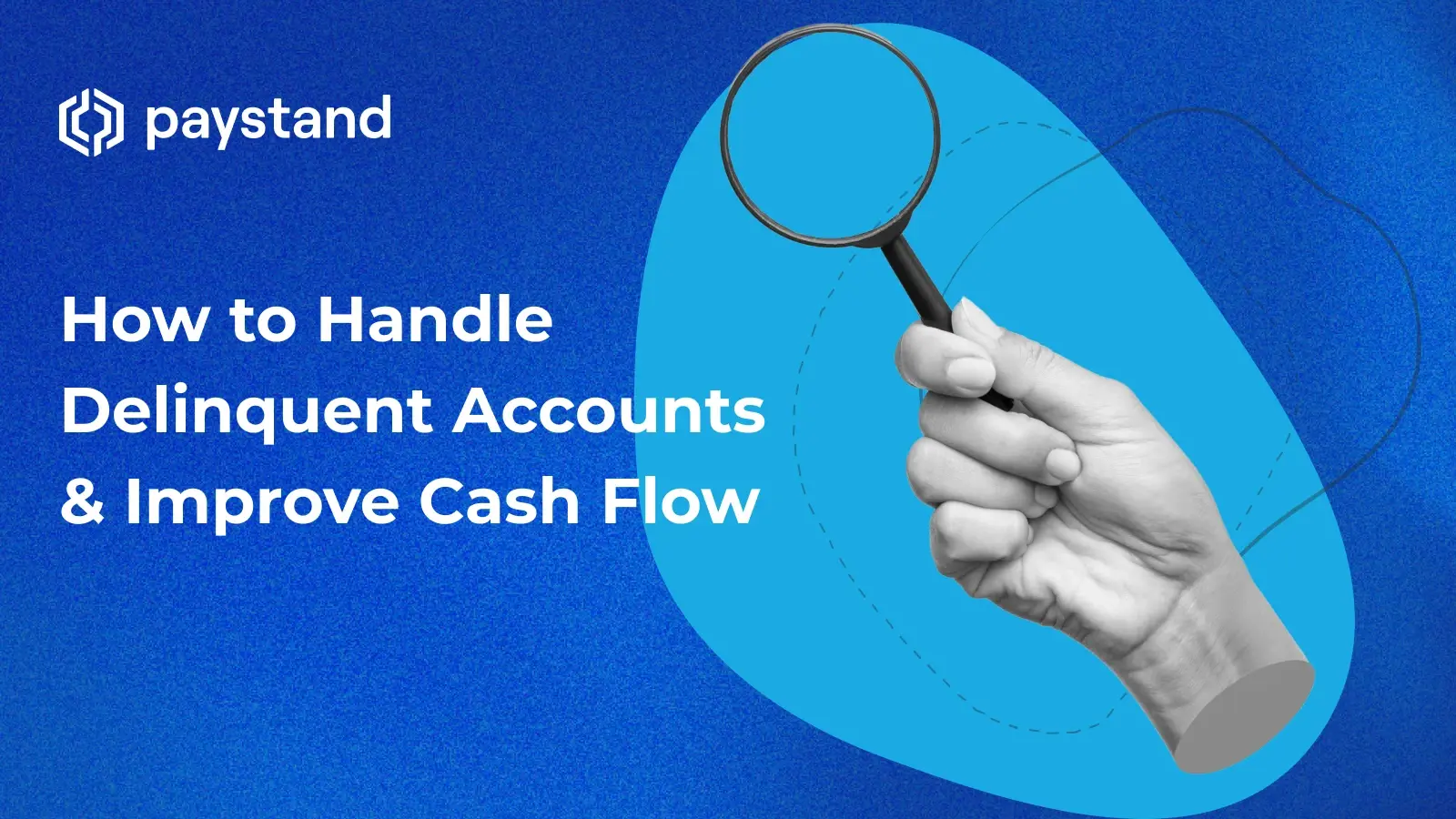How to Handle Delinquent Accounts & Improve Cash Flow

Table of Contents
- What is a delinquent account?
- What are the causes of delinquent accounts?
- How delinquent accounts affect accounts receivable
- Good habits to handle delinquent accounts
- Collections strategies for different types of delinquent customers
- How online payments can minimize delinquency
- Optimize accounts receivable management with Paystand
Key Takeaways
- Delinquent accounts occur when customers fail to make timely payments, disrupting cash flow and increasing financial risk.
- Late payments negatively impact accounts receivable (AR) by reducing cash flow, increasing administrative costs, raising bad debt risk, and straining customer relationships.
- A structured collections process tailored to different delinquency stages helps recover overdue payments while maintaining customer relationships.
- Online payment solutions significantly reduce overdue accounts, including automated billing, multiple payment methods, and real-time tracking.
Managing delinquent accounts is one of the most challenging business aspects. Late or missed payments disrupt cash flow, increase operational costs, and strain customer relationships. While some delinquency is inevitable, businesses proactively managing past-due accounts can significantly reduce financial risk and improve overall accounts receivable (AR) performance.
This guide covers managing delinquent accounts, including causes and collections strategies for late-paying customers. We'll discuss best practices to reduce delinquency and how digital payment solutions can help prevent overdue payments.
What Is a Delinquent Account?
A delinquent account is any account in which the customer has failed to make the required payment by the due date. This can apply to various financial agreements, including credit cards, loans, and invoices for goods or services. The severity of a delinquent account depends on how long it remains unpaid, and businesses typically categorize accounts based on the number of days past due.
Delinquent accounts can significantly impact business operations, making it crucial for companies to establish clear policies and procedures to handle overdue payments efficiently.
Delinquent Account Meaning & Examples
To better illustrate the concept, let’s look at a few common examples of delinquent accounts:
| Type of Account | Example of Delinquency |
|---|---|
| Business Invoice | A company issues an invoice with net 30 payment terms, but the client hasn’t paid after 45 days. |
| Consumer Loan | A borrower misses two consecutive car loan payments, making the loan delinquent. |
| Credit Card Account | A cardholder does not make at least the minimum payment on their credit card bill by the due date. |
| Subscription Service | A customer fails to update their payment method, causing their subscription to lapse due to a missed payment. |
The key difference between delinquency and default is that delinquent accounts still have the potential to be paid. In contrast, a defaulted account is typically written off as bad debt after prolonged non-payment. This distinction is critical because businesses need different strategies to handle delinquent accounts versus defaulted accounts.
What Are the Causes of Delinquent Accounts?
Understanding why delinquent accounts occur is the first step toward reducing their impact. While each customer situation is different, most cases of late payments fall into one of the following categories:
- Financial hardship: One of the most common reasons for delinquency is that customers simply cannot afford to pay. Unexpected expenses, job loss, or cash flow issues can prevent individuals and businesses from making timely payments.
- Poor invoice or payment management: Some customers miss payments due to disorganization rather than an inability to pay. If a business does not have a clear invoicing process or customers are not tracking due dates, delinquency can increase.
- Disputed charges: Customers may intentionally withhold payments if they have concerns about pricing, service quality, or contract terms. Resolving disputes quickly is essential to avoid prolonged delinquency, as unresolved conflicts can lead to even more financial losses.
- Complicated or limited payment options: If a business does not offer convenient payment options, such as online payments, credit cards, or automated billing, customers may delay payments simply because completing the transaction is a hassle. Ensuring the payment process is simple and intuitive can significantly reduce delinquency rates.
How Delinquent Accounts Affect Accounts Receivable
Delinquent accounts impact more than an individual transaction; they create widespread financial and operational challenges for businesses.
- Reduced cash flow: Late payments can leave businesses struggling to cover expenses, pay employees, and invest in growth opportunities. If cash flow slows, companies may rely on credit lines or external financing to stay afloat. This dependency on external funding can increase costs and put long-term financial stability at risk.
- Increased administrative costs: Managing delinquent accounts requires additional time and resources. Businesses must send reminders, make collection calls, and possibly engage legal or third-party collection services, all of which add to operational costs and reduce profitability.
- Higher risk of bad debt: The longer an account remains unpaid, the less likely the business is to recover the amount owed. After a certain period, the account may need to be written off as a bad debt, resulting in direct financial losses. To mitigate this risk, companies should implement early intervention strategies to recover payments before they reach the point of no return.
- Strained customer relationships: Aggressive collection efforts can damage long-term customer relationships. A well-managed delinquency strategy should balance firm payment policies with customer retention efforts, ensuring businesses maintain positive relationships while enforcing payment obligations.
Good Habits to Handle Delinquent Accounts
The best way to manage delinquency is prevention. Businesses can minimize overdue payments by adopting proactive financial habits that encourage customers to pay on time.
1. Set Clear Payment Terms Upfront
Before extending credit or invoicing customers, establish well-defined payment terms, including:
- Due dates
- Late fees or penalties for missed payments
- Accepted payment methods
Clearly communicating these terms in contracts, invoices, and payment agreements ensures customers understand their obligations and reduces ambiguity. Regularly reminding customers of these terms through emails or account statements can reinforce timely payments.
Additionally, consider adding early payment incentives, such as discounts for customers who pay before the due date. This can create a sense of urgency and encourage prompt payments.
2. Invoice Promptly and Accurately
Timely and accurate invoicing is essential for on-time payments. Businesses should send invoices immediately after delivering goods or services. Delays in invoicing can create confusion and reduce customers' urgency to pay. Additionally, invoices should be detailed, error-free, and include all relevant payment information to prevent unnecessary disputes.
Consider using invoicing software that automates the process, ensuring consistency and accuracy. Automated invoicing also enables tracking of sent invoices and provides insights into payment patterns.
Furthermore, providing digital invoices with embedded payment links can streamline the process, reducing customer friction and increasing the likelihood of on-time payments.
3. Implement Automated Payment Reminders
An automated system that sends reminders before and after due dates can significantly reduce late payments. These reminders can be sent via email, SMS, or automated phone calls and should include invoice details, due dates, and easy payment links.
In addition to automated reminders, consider adding escalation procedures, such as follow-up calls from the AR team for unpaid accounts after a certain period.
Another effective tactic is offering customers an option to set up recurring payments or autopay, which ensures invoices are settled on time without manual intervention.
4. Offer Flexible Payment Options
Customers are more likely to pay on time if they have multiple payment options available, such as:
- Online payments (credit/debit cards, ACH transfers)
- Recurring billing for subscription-based services
- Mobile payment solutions (Apple Pay, Google Pay, PayPal, Venmo)
By eliminating payment friction, businesses can improve collection rates and ensure customers can settle their accounts conveniently.
Additionally, offering installment plans for larger invoices can help businesses recover payments from customers facing short-term cash flow constraints.
5. Establish a Formal Collections Process
If a payment is overdue, having a structured collections approach helps businesses recover funds efficiently. This process should include escalating collection efforts, from friendly reminders to more formal actions.
- 1-30 days late: Send a friendly reminder via email or phone, offering flexible payment options.
- 30-60 days late: Follow up with more assertive calls or written notices. Consider offering a payment plan.
- 60+ days late: Send a formal demand letter and escalate to collections or legal action if necessary.
Collections Strategies for Different Types of Delinquent Customers
Not all delinquent customers are the same, and a one-size-fits-all collections approach can be ineffective. The best collections strategy depends on the customer's payment history and how overdue the payment is.
| Delinquency Stage | Recommended Action |
|---|---|
| Early-Stage Delinquency (1-30 Days Late) | Send a friendly reminder via email or phone, offering flexible payment options. |
| Mid-Stage Delinquency (30-60 Days Late) | Follow up with more assertive calls or written notices. Consider offering a payment plan. |
| Late-Stage Delinquency (60+ Days Late) | Send a formal demand letter and escalate to collections or legal action if necessary. |
By segmenting delinquent accounts based on risk level, businesses can recover more payments while preserving customer relationships where possible.
How Online Payments Can Minimize Delinquency
One of the most effective ways to reduce delinquency rates is to simplify payment. Online payments offer several advantages that encourage timely payments:
- Convenience and accessibility: Online payment portals allow customers to pay anytime, anywhere, eliminating excuses related to inconvenience or limited office hours.
- Automated recurring billing: Businesses can set up recurring payments for subscription-based services or installment plans, ensuring on-time collection without requiring customer action.
- Real-time payment tracking: Online payment systems provide instant confirmation of transactions, allowing businesses to quickly follow up on overdue accounts and identify potential payment issues.
- Multiple payment methods: Offering various online payment options, such as credit cards, ACH transfers, and mobile wallets, reduces barriers for customers and encourages prompt payments.
- Integration with accounts receivable software: Modern online payment solutions integrate seamlessly with AR systems, automating collections processes and reducing manual tracking efforts.
Optimize Accounts Receivable Management with Paystand
Effectively handling delinquent accounts requires a combination of preventative
If your business still relies on outdated payment methods, manual collections, or high-fee transactions, it’s time to ask yourself: Is your accounts receivable process working for you, or are you working for it?
Traditional AR management is riddled with inefficiencies, like payment delays, costly fees, and administrative burdens that chip away at revenue. But what if your business didn’t have to wait for payments? What if you could eliminate unnecessary fees, automate collections, and regain control over your cash flow?
Paystand replaces legacy payment systems with a radically efficient, fee-free payments network that transforms how businesses manage receivables. With blockchain-based automation, real-time fund verification, and seamless bank-to-bank transfers, Paystand eliminates the friction of traditional payments, empowering businesses to:
- Reduce overdue accounts with automated invoicing, reminders, and AI-driven payment recovery strategies.
- Increase cash flow certainty by offering self-service payment options that allow customers to pay instantly.
- Cut transaction costs to zero with Paystand’s zero-fee payments network, removing the need for costly credit card fees or processing charges.
- Gain financial transparency and control with blockchain-based records that provide an immutable, real-time view of payments.
The question is no longer whether your AR process can be improved; it’s whether your business can afford to keep operating the old way.
Now is the time to join the financial revolution. Book a demo today to see how Paystand can help you reclaim control of your receivables, accelerate cash flow, and future-proof your business.






